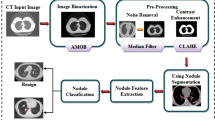Abstract
Lung cancer is a disease of abnormal cells multiplying and growing into a tumor in the human lung. It is the most dangerous and widespread cancer in the world. According to the stage of discovery of cancer cells in the lung, the process of early detection plays a very important and essential role to avoid serious advanced stages to reduce its percentage of distribution. Our lung cancer detection system basically detects and recognizes Juxta-pleural pulmonary nodules; which are attached to the wall of the lung. It is done in 4 stages such as obtaining ROI (Region Of Interest), Segmentation, Feature extraction and Classification.
CT (Computed Tomography) is considered to be the best modality for the diagnosis of Lung cancer. ROI can be selected either manually or automatically. Automated ROI retrieval is preferred as manual selection is considered to be tedious and time consuming as the operator has to go through the dataset slice by slice and frame by frame. Ray-casting algorithm is used to segment nodule and neural networks are used to classify the nodules appropriately.
Access this chapter
Tax calculation will be finalised at checkout
Purchases are for personal use only
Preview
Unable to display preview. Download preview PDF.
Similar content being viewed by others
References
Wey, Y., Jia, T., Lin, M.-X.: Autonomous detection of Solitary Pulmonary nodules on CT images for Computer aided diagnosis. In: IEEE Chinese Control and Decision Conference (2011) 978-1-4244-8738-7/11
Wu, S., Wang, J.: Pulmonary nodules 3D detection on serial CT scans. In: IEEE Third Global Congress on Intelligent Systems (2012) 978-0-7695-4860-9/12
Kuruvilla, J., Gunavathi, K.: Detection of Lung cancer using morphological operations. International Journal of Scientific & Engineering Research (2013) ISSN 2229-5518
Sun, S.-S., Li, H., Hou, X.-R., Kang, Y., Zhao, H.: Automatic segmentation of pulmonary nodules in CT images (2007) 1-4424-1120-3/07 IEEE
Amal, A., Hossam, A., James, G., Aly, F., Salwa, E., Sabry, Mohammed, Robert, F., Sahar, H., Rebecca, M.: Variational approach for segmentation of Lung nodules. In: 18th IEEE Conference on Image Processing (2011) 978-1-4577-1033-3/11
Lai, J., Ye, M.: Active contour based Lung field segmentation. In: International Conference on Intelligent Human Machine Systems and Cybernetics IEEE (2009) 978-0-7695-3752-8/09
Artit, C., Yury, D., Anthony, P., David, F., Claudia, H.: Segmentation of Juxta-pleural pulmonary nodules using a Robust surface estimate. International Journal of Biomedical Engineering, 10.1155/2011/632195
Ye, X., Musib, S., Abdel, D., Gareth, B., Greg, S.: Shape based CT lung nodule segmentation using five-dimensional mean shift clustering and mem with shape information. IEEE (2009) 978-1-4244-3932-4/09
Nie, S., Wang, Y., He, C., Ji, F., Liang, J.: A Segmentation Method for Sub-solid pulmonary nodules based on Fuzzy C-means Clustering. In: 5th International Conference on Biomedical Engineering and Informatics, BMEI 2012 (2012) 978-1-4673-1184-7/12
Si, G., Cai, J., Kang, Y.: A three dimensional Ray casting method for Juxta- pleural nodule segmentation in thoracic CT nodules. In: IEEE International Conference on Information and Automation (2012) 978-1-4673-2237-9/12
Author information
Authors and Affiliations
Corresponding author
Editor information
Editors and Affiliations
Rights and permissions
Copyright information
© 2015 Springer International Publishing Switzerland
About this paper
Cite this paper
Sariya, K., Ravishankar, M. (2015). Classifying Juxta-Pleural Pulmonary Nodules. In: Satapathy, S., Biswal, B., Udgata, S., Mandal, J. (eds) Proceedings of the 3rd International Conference on Frontiers of Intelligent Computing: Theory and Applications (FICTA) 2014. Advances in Intelligent Systems and Computing, vol 328. Springer, Cham. https://doi.org/10.1007/978-3-319-12012-6_66
Download citation
DOI: https://doi.org/10.1007/978-3-319-12012-6_66
Publisher Name: Springer, Cham
Print ISBN: 978-3-319-12011-9
Online ISBN: 978-3-319-12012-6
eBook Packages: EngineeringEngineering (R0)




